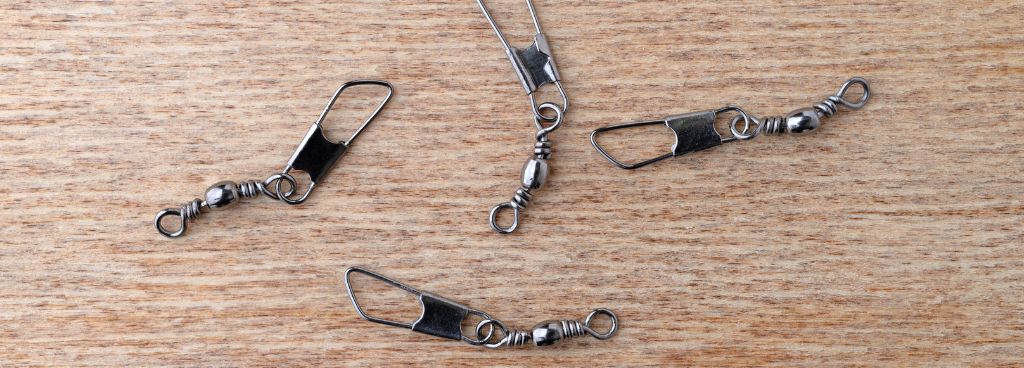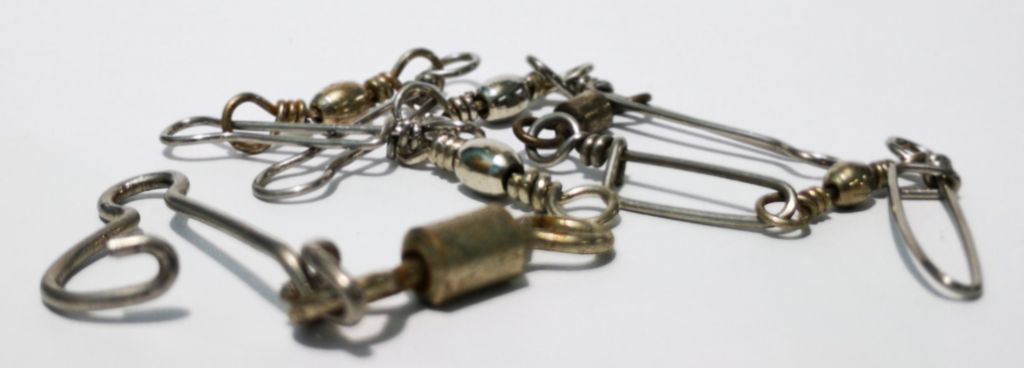Stories Worth Reeling In...
Last Updated on October 2, 2023
Fishing, an artful pursuit that melds nature, skill, and technique, often calls for an array of tools and tackle to enhance the angler’s chances of success. Among these tools, swivels play a quietly indispensable role.
These small but mighty components can make a significant difference in your angling experience. From preventing line twists to improving lure presentation and aiding in bait rigs, swivels are versatile tools that every angler should have in their tackle box.
So, let’s dive into the world of fishing swivels and discover how these unassuming little devices can make a big impact on your angling adventures.
Table of Contents
Swivels, those unpretentious yet indispensable devices in the world of fishing, are worthy of closer inspection. At their core, fishing swivels are simple, mechanical components designed to serve a variety of functions within your tackle setup.
A fishing swivel is a small, barrel-shaped device that rotates freely around a central axis. It’s a connecting link between various parts of your fishing rig, primarily the mainline and leader or terminal tackle. The swivel’s magic lies in its ability to swivel or spin freely, preventing your fishing line from twisting or tangling.
Swivels typically consist of two essential components: the main body and the attached rings or loops. The main body is the central part of the swivel, housing the bearing that allows it to rotate freely. On either end of the main body, you’ll find rings or loops where you can attach your fishing line, leader, or other terminal tackle.
Swivels are like the multitools of the fishing world. They serve a wide array of functions, making them indispensable for anglers of all levels. Here’s a glimpse of their versatility:
Just as there are various fish species to target and countless fishing techniques to master, the world of fishing swivels is equally diverse. Each type of swivel brings its own unique advantages and applications to the table.

1. Barrel Swivels:
Features: Barrel swivels are the quintessential swivel type. They feature a cylindrical body with rings or loops at each end. The main body is known for its compact design, making it an excellent choice for reducing line twists.
Applications: These versatile swivels are widely used in both freshwater and saltwater fishing. Their simplicity and effectiveness make them a go-to choice for preventing line twists with various lures and rigs.
2. Ball-Bearing Swivels:
Features: Ball-bearing swivels take smooth rotation to the next level. They incorporate ball bearings within the main body, providing frictionless, 360-degree movement. This results in exceptional twist resistance and reduced friction on your line.
Applications: Ball-bearing swivels shine in scenarios where line twist resistance is paramount. They are favored for heavy-duty fishing, trolling, and targeting large, hard-fighting species. These swivels ensure your line stays untangled and maintains its strength under immense pressure.
3. Snap Swivels:
Features: Snap swivels combine the benefits of a swivel with a snap or clip for easy lure attachment. They have a streamlined design and a snap for quick changes of lures or other terminal tackle.
Applications: Snap swivels are fantastic for anglers who frequently change lures or baits. They’re commonly used in situations where adaptability and convenience are key, such as casting and retrieving lures or when fishing with multiple bait setups.
4. Three-Way Swivels:
Features: Three-way swivels, as the name suggests, have three rings or loops, allowing for multiple connections. They often feature a central ring with two perpendicular rings. This design facilitates complex rigging setups.
Applications: These swivels are favored for specialized rigs like three-way rigs or drop shot rigs. They’re versatile tools for presenting baits in unique ways, making them a go-to choice for anglers seeking versatility in their presentations.
5. Crane Swivels:
Features: Crane swivels are known for their strength and durability. They have a distinctive design with a rounded, open eyelet and a loop on the other end. The rounded eyelet helps reduce line friction.
Applications: Crane swivels excel in situations where you need to minimize line failure due to abrasion or intense pressure. They are commonly used in deep-sea fishing and for targeting big game species where line strength is critical.
6. Crossline Swivels:
Features: Crossline swivels, also known as crosslock or fastlock swivels, have a unique, X-shaped design with a lock mechanism. This allows for quick and secure attachment of terminal tackle.
Applications: Crossline swivels are favored by anglers who want efficient and secure connections when using lures or rigs that require precision in bait presentation. Their design ensures that your terminal tackle remains firmly in place.
Swivels are versatile tools in your angler’s toolkit, and knowing how to use them effectively can significantly enhance your fishing experience. Here are some expert tips to help you make the most of swivels:

While swivels can be powerful allies in your fishing endeavors, common mistakes in their usage can hamper your success. Let’s explore these errors and learn how to avoid them:
Proper rigging and placement are key. Ensure swivels are not too close to hooks, sinkers, or other tackle components that could cause tangles.
Swivels are designed to be strong and should not significantly weaken your line if properly matched to your setup. Follow the manufacturer’s specifications.
While fly fishing typically doesn’t involve swivels, they can be used in certain situations, such as when fishing streamers or sinking lines. In such cases, choose swivels designed for fly fishing.
The placement depends on your specific setup and fishing style. However, a common practice is to attach a swivel between your mainline and leader to reduce line twist.
Swivels can last a long time with proper care. Replace them if you notice signs of wear, or corrosion, or if they become difficult to rotate.
In conclusion, swivels might seem like small components in your fishing setup, but their impact is anything but insignificant. They contribute to smoother casting, fewer line tangles, and, ultimately, more successful fishing trips. As you embark on your next adventure, remember to consider the power of swivels and the advantages they bring to your angling game.
Now, it’s time to hit the water with this newfound knowledge and put it into practice. Whether you’re a novice angler or a seasoned pro, experimenting with swivels can lead to more productive and enjoyable fishing experiences. Tight lines and happy angling!